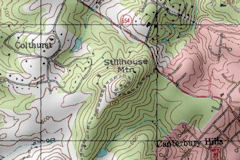by James A. Bacon
An Environmental Assessment (EA) of the Charlottesville Bypass prepared by the state and submitted to the Federal Highway Administration (FHWA) is based on an outdated highway design, uses a deeply flawed traffic model and fails to consider transportation alternatives, charges the Southern Environmental Law Center (SELC) in a formal response to the assessment.
Having failed to halt the Charlottesville Bypass at the level of state, regional and state government, the SELC and its allies are taking their case to the feds, who must review the EA before granting final approval for the federally funded project. The 6.5-mile bypass would circumvent a congested stretch of U.S. 29 north of Charlottesville and a cost of roughly $245 million.
“I don’t think the FHWA has the information it needs to made a decision,” says Morgan Butler, SELC senior attorney. When asked what outcome he hoped to get from the federal review, he said: “The FHWA could say, ‘We want [the Virginia Department of Transportation] to go back and take a closer look.”
By contrast, bypass supporters find the environmental assessment “a very defensible document,” in the words of Neil Williamson, president of the Free Enterprise Forum in Charlottesville. “VDOT is moving fairly, methodically and carefully,” he says. The EA addressed important issues such as the noise impact not considered in the original Environmental Impact Statement.
Barring a rejection of the EA by federal authorities or the filing of a lawsuit, construction of the bypass is scheduled to begin November 2013.
Outdated design. The SELC argues that the environmental assessment is based upon a conceptual VDOT bypass design that differs in important respects from the design submitted by winning bidder Skanksa/Branch. Of particular concern is the configuration of the southern terminus connecting to the U.S. 250 Bypass.
The original VDOT design anticipated a grade of 4% as the highway crossed over Stillhouse Mountain near the southern terminus. Skanska/Branch increased the elevation of the bypass in order to reduce the significant cost of blasting and removing rock. But that would create a new problem: Cars and trucks entering the bypass from the south would encounter an extremely steep grade — 11.26%, or more than twice the average grade of Interstate 64 as it climbs Afton Mountain. Trucks struggling to accelerate up that grade could block traffic and reduce the desired level of service.
Additionally, noted the SELC critique, one of the other bidders, American Infrastructure, had filed a protest against the awarding of the contract to Skanska/Branch on the grounds that the southern terminus design was deficient. “American Infrastructure noted that the traffic lights included in the design would likely cause long queues that would impede flow on the eastbound 250 Bypass during special events on the University’s North Grounds.”
Flawed traffic analysis. Citing an analysis it contracted from Smart Mobility Inc., the SELC contends that the VDOT traffic projections contain a major methodological error: treating growth of “external” traffic (originating outside the Metropolitan Planning Office boundaries) as “through” trips, meaning that all such vehicles will travel through the region to destinations outside the region. However, some of those trips will be, in fact, to destinations in Charlottesville and Albemarle County. The model projects that the percentage of “through” trips on U.S. 29 will jump from 13.5% in 2010 to 51% in 2040, thus inflating traffic counts and the putative benefits of the bypass.
No look at alternatives. VDOT never gave serious consideration to bypass alternatives, SELC argues. Installing grade-separated interchanges at the two busiest intersections, Hydraulic Road and Rio Road, would achieve greater delay reductions than the bypass — and it would benefit everyone using the 29 corridor, not just people passing through the region. Building the two interchanges also would cost less.
Representing much of the Charlottesville business community, the Free Enterprise Institute has long supported the bypass. In comments submitted to the FHWA, Neil Williamson minimized the changes that have taken place since the original Environmental Impact Statement was completed two decades ago. “Even though some of the areas on US29 North have been rezoned and/or developed since 1995, these areas have been designated for high density growth since at least the 1984 Comprehensive Land Use Plan. This designation was factored in when the original route was developed.”
The EA was correct in stating that the bypass would divert up to 28% of U.S. 29 traffic to the bypass by 2o4o, the Institute wrote. “The project will result in significant improvement in traffic flow on the new Business 29.”



